Building Asset Value Mapping in Support of Flood Risk Assessments: A Case Study of Shanghai, China
Abstract
:1. Introduction
2. Materials and Methods
2.1. Study Area
2.2. Data
2.3. Method
2.3.1. Township-Level BFA Estimation
2.3.2. Disaggregation of BFA from the Township to the Regular Grid Cell
2.3.3. Evaluation of the Performance of the BFA Disaggregation Model
2.3.4. Valuation of Building Assets
3. Results
3.1. Building Asset Value Map
3.2. Performance Evaluation of the Disaggregated BFA Map
3.3. Comparison of Different Exposure Models on Flood Exposure Assessment
4. Discussion
4.1. Application of the Building Asset Value Map in Scenario-Based Flood Damage Modelling
4.2. Limitations
5. Conclusions
Author Contributions
Funding
Acknowledgments
Conflicts of Interest
References
- Ward, P.J.; Jongman, B.; Aerts, J.C.J.H.; Bates, P.D.; Botzen, W.J.W.; Diaz Loaiza, A.; Hallegatte, S.; Kind, J.M.; Kwadijk, J.; Scussolini, P.; et al. A global framework for future costs and benefits of river–flood protection in urban areas. Nat. Clim. Chang. 2017, 7, 642–646. [Google Scholar] [CrossRef]
- Jevrejeva, S.; Jackson, L.P.; Grinsted, A.; Lincke, D.; Marzeion, B. Flood damage costs under the sea level rise with warming of 1.5 °C and 2 °C. Environ. Res. Lett. 2018, 13. [Google Scholar] [CrossRef]
- Amadio, M.; Mysiak, J.; Carrera, L.; Koks, E.E. Improving flood damage assessment models in Italy. Nat. Hazards 2016, 82, 2075–2088. [Google Scholar] [CrossRef] [Green Version]
- Ye, M.; Wu, J.; Wang, C.; He, X. Historical and Future Changes in Asset Value and GDP in Areas Exposed to Tropical Cyclones in China. Wea. Clim. Soc. 2019, 11, 307–319. [Google Scholar] [CrossRef]
- Koks, E. Moving flood risk modelling forwards. Nat. Clim. Chang. 2018, 8, 561–562. [Google Scholar] [CrossRef]
- Molinari, D.; Scorzini, A.R. On the Influence of Input Data Quality to Flood Damage Estimation: The Performance of the INSYDE Model. Water 2017, 9, 688. [Google Scholar] [CrossRef]
- Li, W.; Wen, J.; Xu, B.; Li, X.; Du, S. Integrated Assessment of Economic Losses in Manufacturing Industry in Shanghai Metropolitan Area Under an Extreme Storm Flood Scenario. Sustainability 2019, 11, 126. [Google Scholar] [CrossRef]
- Fang, Y.; Du, S.; Scussolini, P.; Wen, J.; He, C.; Huang, Q.; Gao, J. Rapid Population Growth in Chinese Floodplains from 1990 to 2015. Int. J. Environ. Res. Public Health 2018, 15, 1602. [Google Scholar] [CrossRef]
- Rana, I.A.; Routray, J.K. Multidimensional Model for Vulnerability Assessment of Urban Flooding: An Empirical Study in Pakistan. Int. J. Disaster Risk Sci. 2018, 9, 359–375. [Google Scholar] [CrossRef]
- Du, S.; He, C.; Huang, Q.; Shi, P. How did the urban land in floodplains distribute and expand in China from 1992–2015? Environ. Res. Lett. 2018, 13, 034018. [Google Scholar] [CrossRef] [Green Version]
- Paprotny, D.; Terefenko, P. New estimates of potential impacts of sea level rise and coastal floods in Poland. Nat. Hazards 2017, 85, 1249–1277. [Google Scholar] [CrossRef]
- Oubennaceur, K.; Chokmani, K.; Nastev, M.; Lhissou, R.; El Alem, A. Flood risk mapping for direct damage to residential buildings in Quebec, Canada. Int. J. Disaster Risk Reduct. 2019, 33, 44–54. [Google Scholar] [CrossRef]
- Röthlisberger, V.; Zischg, A.P.; Keiler, M. A comparison of building value models for flood risk analysis. Nat. Hazards Earth Syst. Sci. 2018, 18, 2431–2453. [Google Scholar] [CrossRef]
- Molinari, D.; De Bruijn, K.M.; Castillo–Rodríguez, J.T.; Aronica, G.T.; Bouwer, L.M. Validation of flood risk models: Current practice and possible improvements. Int. J. Dis. Risk Reduct. 2019, 33, 441–448. [Google Scholar] [CrossRef]
- Chen, K.; McAneney, J.; Blong, R.; Leigh, R.; Hunter, L.; Magill, C. Defining area at risk and its effect in catastrophe loss estimation: A dasymetric mapping approach. Appl. Geogr. 2004, 24, 97–117. [Google Scholar] [CrossRef]
- Thieken, A.; Müller, M.; Kleist, L.; Seifert, I.; Borst, D.; Werner, U. Regionalisation of asset values for risk analyses. Nat. Hazards Earth Syst. Sci. 2006, 6, 167–178. [Google Scholar] [CrossRef] [Green Version]
- Figueiredo, R.; Martina, M. Using open building data in the development of exposure data sets for catastrophe risk modelling. Nat. Hazards Earth Syst. Sci. 2016, 16, 417–429. [Google Scholar] [CrossRef] [Green Version]
- Merz, B.; Kreibich, H.; Schwarze, R.; Thieken, A. Review article ‘Assessment of economic flood damage’. Nat. Hazards Earth Syst. Sci. 2010, 10, 1697–1724. [Google Scholar] [CrossRef]
- Chinh, D.T.; Dung, N.V.; Gain, A.K.; Kreibich, H. Flood Loss Models and Risk Analysis for Private Households in Can Tho City, Vietnam. Water 2017, 9, 313. [Google Scholar] [CrossRef]
- Gunasekera, R.; Ishizawa, O.; Aubrecht, C.; Blankespoor, B.; Murray, S.; Pomonis, A.; Daniell, J.E. Developing an adaptive global exposure model to support the generation of country disaster risk profiles. Earth–Sci. Rev. 2015, 150, 594–608. [Google Scholar] [CrossRef]
- Dutta, D.; Herath, S.; Musiake, K. A mathematical model for flood loss estimation. J. Hydrol. 2003, 277, 24–49. [Google Scholar] [CrossRef]
- Merz, B.; Kreibich, H.; Thieken, A.; Schmidtke, R. Estimation uncertainty of direct monetary flood damage to buildings. Nat. Hazards Earth Syst. Sci. 2004, 4, 153–163. [Google Scholar] [CrossRef] [Green Version]
- Amadio, M.; Mysiak, J.; Marzi, S. Mapping Socioeconomic Exposure for Flood Risk Assessment in Italy. Risk Anal. 2018. [Google Scholar] [CrossRef] [PubMed]
- Jongman, B.; Kreibich, H.; Apel, H.; Barredo, J.I.; Bates, P.D.; Feyen, L.; Gericke, A.; Neal, J.; Aerts, J.C.J.H.; Ward, P.J. Comparative flood damage model assessment: towards a European approach. Nat. Hazards Earth Syst. Sci. 2012, 12, 3733–3752. [Google Scholar] [CrossRef] [Green Version]
- De Moel, H.; Aerts, J.C.J.H. Effect of uncertainty in land use, damage models and inundation depth on flood damage estimates. Nat. Hazards 2011, 58, 407–425. [Google Scholar] [CrossRef]
- De Moel, H.; Bouwer, L.M.; Aerts, J.C.J.H. Uncertainty and sensitivity of flood risk calculations for a dike ring in the south of the Netherlands. Sci. Total Environ 2014, 473–474, 224–234. [Google Scholar] [CrossRef] [PubMed]
- Meyer, V.; Becker, N.; Markantonis, V.; Schwarze, R.; van den Bergh, J.C.J.M.; Bouwer, L.M.; Bubeck, P.; Ciavola, P.; Genovese, E.; Green, C.; et al. Review article: Assessing the costs of natural hazards–State of the art and knowledge gaps. Nat. Hazards Earth Syst. Sci. 2013, 13, 1351–1373. [Google Scholar] [CrossRef]
- Apel, H.; Martìnez Trepat, O.; Hung, N.N.; Chinh, D.T.; Merz, B.; Dung, N.V. Combined fluvial and pluvial urban flood hazard analysis: concept development and application to Can Tho city, Mekong Delta, Vietnam. Nat. Hazards Earth Syst. Sci. 2016, 16, 941–961. [Google Scholar] [CrossRef]
- Viero, D.P.; Peruzzo, P.; Carniello, L.; Defina, A. Integrated mathematical modeling of hydrological and hydrodynamic response to rainfall events in rural lowland catchments. Water Resour. Res. 2016, 50, 5941–5957. [Google Scholar] [CrossRef]
- Seifert, I.; Thieken, A.H.; Merz, M.; Borst, D.; Werner, U. Estimation of industrial and commercial asset values for hazard risk assessment. Nat. Hazards 2010, 52, 453–479. [Google Scholar] [CrossRef]
- Wünsch, A.; Herrmann, U.; Kreibich, H.; Thieken, A.H. The Role of Disaggregation of Asset Values in Flood Loss Estimation: A Comparison of Different Modeling Approaches at the Mulde River, Germany. Environ. Manag. 2009, 44, 524–541. [Google Scholar] [CrossRef] [PubMed] [Green Version]
- Wu, J.; Li, Y.; Li, N.; Shi, P. Development of an Asset Value Map for Disaster Risk Assessment in China by Spatial Disaggregation Using Ancillary Remote Sensing Data. Risk Anal. 2018, 38, 17–30. [Google Scholar] [CrossRef] [PubMed]
- Silva, V.; Crowley, H.; Varum, H.; Pinho, R. Seismic risk assessment for mainland Portugal. Bull. Earthq. Eng. 2014, 13, 429–457. [Google Scholar] [CrossRef]
- De Moel, H.; van Vliet, M.; Aerts, J.C.J.H. Evaluating the effect of flood damage–reducing measures: A case study of the unembanked area of Rotterdam, the Netherlands. Reg. Environ. Chang. 2014, 14, 895–908. [Google Scholar] [CrossRef]
- Kleist, L.; Thieken, A.H.; Köhler, P.; Müller, M.; Seifert, I.; Borst, D.; Werner, U. Estimation of the regional stock of residential buildings as a basis for a comparative risk assessment in Germany. Nat. Hazards Earth Syst. Sci. 2006, 6, 541–552. [Google Scholar] [CrossRef]
- Wu, J.; Li, N.; Shi, P. Benchmark wealth capital stock estimations across China’s 344 prefectures: 1978 to 2012. China Econ. Rev. 2014, 31, 288–302. [Google Scholar] [CrossRef]
- FEMA (Federal Emergency Management Agency). HAZUS: Multi–Hazard Loss Estimation Model Methodology—Flood Model; FEMA: Washington, DC, USA, 2003.
- Wang, J.; Gao, W.; Xu, S.Y.; Yu, L.Z. Evaluation of the combined risk of sea level rise, land subsidence, and storm surges on the coastal areas of Shanghai, China. Clim. Chang. 2012, 115, 537–558. [Google Scholar] [CrossRef]
- Hallegatte, S.; Green, C.; Nicholls, R.J.; Corfee–Morlot, J. Future flood losses in major coastal cities. Nat. Clim. Chang. 2013, 3, 802–806. [Google Scholar] [CrossRef]
- Balica, S.F.; Wright, N.G.; van der Meulen, F. A flood vulnerability index for coastal cities and its use in assessing climate change impacts. Nat. Hazards 2012, 64, 73–105. [Google Scholar] [CrossRef] [Green Version]
- Du, S.; Gu, H.; Wen, J.; Chen, K.; Van Rompaey, A. Detecting Flood Variations in Shanghai over 1949–2009 with Mann–Kendall Tests and a Newspaper–Based Database. Water 2015, 7, 1808–1824. [Google Scholar] [CrossRef]
- Wang, C.; Du, S.; Wen, J.; Zhang, M.; Gu, H.; Shi, Y.; Xu, H. Analyzing explanatory factors of urban pluvial floods in Shanghai using geographically weighted regression. Stoch. Environ. Res. Risk Assess. 2017, 31, 1777–1790. [Google Scholar] [CrossRef]
- Yin, J.; Yu, D.; Yin, Z.; Wang, J.; Xu, S. Modelling the anthropogenic impacts on fluvial flood risks in a coastal mega–city: a scenario–based case study in Shanghai, China. Landsc. Urban Plan. 2015, 136, 144–155. [Google Scholar] [CrossRef]
- Scholten, N. Flood Risk in Shanghai: Economic Impact and Adaptation Options; VU Amsterdam: Amsterdam, The Netherlands, 2016. [Google Scholar]
- SMSB (Shanghai Municipal Statistics Bureau). Shanghai Statistical Yearbook 2015; China Statistics Press: Beijing, China, 2015.
- SMSB. Tabulation on the 2010 Population Census of Shanghai Municipality; China Statistics Press: Beijing, China, 2012.
- Bhaduri, B.; Bright, E.; Coleman, P.; Dobson, J. LandScan: Locating people is what matters. Geoinformatics 2002, 5, 34–37. [Google Scholar]
- Dobson, J.E.; Bright, E.A.; Coleman, P.R.; Durfee, R.C.; Worley, B.A. LandScan: A global population database for estimating populations at risk. Photogramm. Eng. Remote Sens. 2000, 66, 849–858. [Google Scholar]
- Gallup, J.L.; Mellinger, A.D.; Sachs, J.D. Geography and economic development. Int. Reg. Sci. Rev. 1999, 22, 179–232. [Google Scholar] [CrossRef]
- Felkner, J.; Townsend, R. The Geographic Concentration of Enterprise in Developing Countries. Q. J. Econ. 2011, 126, 2005–2061. [Google Scholar] [CrossRef] [PubMed] [Green Version]
- Naroll, R. Floor Area and Settlement Population. Am. Antiq. 1962, 27, 587–589. [Google Scholar] [CrossRef]
- Aubrecht, C.; Steinnocher, K.; Köstl, M.; Züger, J.; Loibl, W. Long–term spatio–temporal social vulnerability variation considering health–related climate change parameters particularly affecting elderly. Nat. Hazards 2013, 68, 1371–1384. [Google Scholar] [CrossRef]
- Blong, R. A new damage index. Nat. Hazards 2003, 30, 1–23. [Google Scholar] [CrossRef]
- Kreibich, H.; Seifert, I.; Merz, B.; Thieken, A.H. Development of FLEMOcs—A new model for the estimation of flood losses in companies. Hydrol. Sci. J. 2010, 55, 1302–1314. [Google Scholar] [CrossRef]
- Penning–Rowsell, E.; Viavattene, C.; Pardoe, J.; Chatterton, J.; Parker, D.; Morris, J. The Benefits of Flood and Coastal Risk Management: A Handbook of Assessment Techniques; Flood Hazard Research Centre: Middlesex, UK, 2010. [Google Scholar]
- Ke, Q. Flood Risk Analysis for Metropolitan Areas—A Case Study for Shanghai; Delft Academic Press: Delft, The Netherlands, 2014. [Google Scholar]
- Research group of Control and Countermeasure of flood. Control and Countermeasure of Flood in China. China Flood Drought Manag. 2014, 24, 46–48. [Google Scholar] [CrossRef]
- Merz, B.; Hall, J.; Disse, M.; Schumann, A. Fluvial flood risk management in a changing world. Nat. Hazards Earth Syst. Sci. 2010, 10, 509–527. [Google Scholar] [CrossRef] [Green Version]
- Prime, T.; Brown, J.M.; Plater, A.J. Flood inundation uncertainty: the case of a 0.5% annual probability flood event. Environ. Sci. Policy 2016, 59, 1–9. [Google Scholar] [CrossRef]
- Brunner, M.I.; Seibert, J.; Favre, A.C. Bivariate return periods and their importance for flood peak and volume estimation. Wire’s Water 2016, 3, 819–833. [Google Scholar] [CrossRef] [Green Version]
- Wadey, M.P.; Brown, J.M.; Haigh, I.D.; Dolphin, T.; Wisse, P. Assessment and comparison of extreme sea levels and waves during the 2013/14 storm season in two UK coastal regions. Nat. Hazards Earth Syst. Sci. 2015, 15, 2209–2225. [Google Scholar] [CrossRef] [Green Version]
- Li, N.; Liu, X.; Xie, W.; Wu, J.; Zhang, P. The Return Period Analysis of Natural Disasters with Statistical Modeling of Bivariate Joint Probability Distribution. Risk Anal. 2013, 33, 134–145. [Google Scholar] [CrossRef]
- Sultana, Z.; Sieg, T.; Kellermann, P.; Müller, M.; Kreibich, H. Assessment of Business Interruption of Flood–Affected Companies Using Random Forests. Water 2018, 10, 1049. [Google Scholar] [CrossRef]
- Koks, E.E.; Bočkarjova, M.; de Moel, H.; Aerts, J.C.J.H. Integrated direct and indirect flood risk modeling: development and sensitivity analysis. Risk Anal. 2015, 35, 882–900. [Google Scholar] [CrossRef]
- Messner, F.; Meyer, V. Flood damage, vulnerability and risk perception—Challenges for flood damage research. In Flood Risk Management: Hazards, Vulnerability and Mitigation Measures; Springer: Berlin, Germany, 2006. [Google Scholar]
- Green, C. The Global Estimation of Losses from Coastal Flooding; Middlesex University: Middlesex, UK, 2010. [Google Scholar]
- Gerl, T.; Bochow, M.; Kreibich, H. Flood Damage Modeling on the Basis of Urban Structure Mapping Using High–Resolution Remote Sensing Data. Water 2014, 6, 2367–2393. [Google Scholar] [CrossRef]
- Schröter, K.; Lüdtke, S.; Redweik, R.; Meier, J.; Bochow, M.; Ross, L.; Nagel, C.; Kreibich, H. Flood loss estimation using 3D city models and remote sensing data. Environ. Modell. Softw. 2018, 105, 118–131. [Google Scholar] [CrossRef]

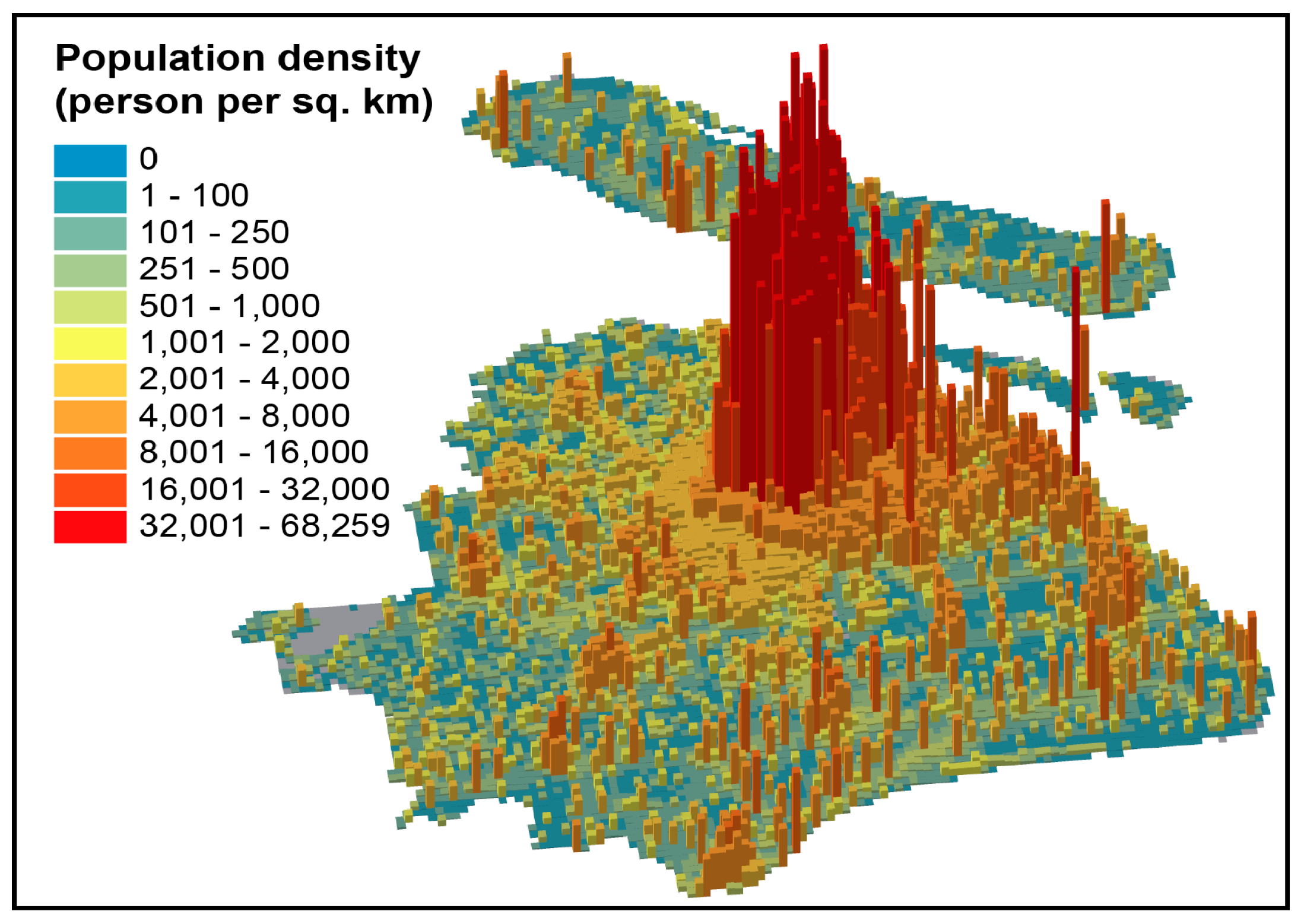
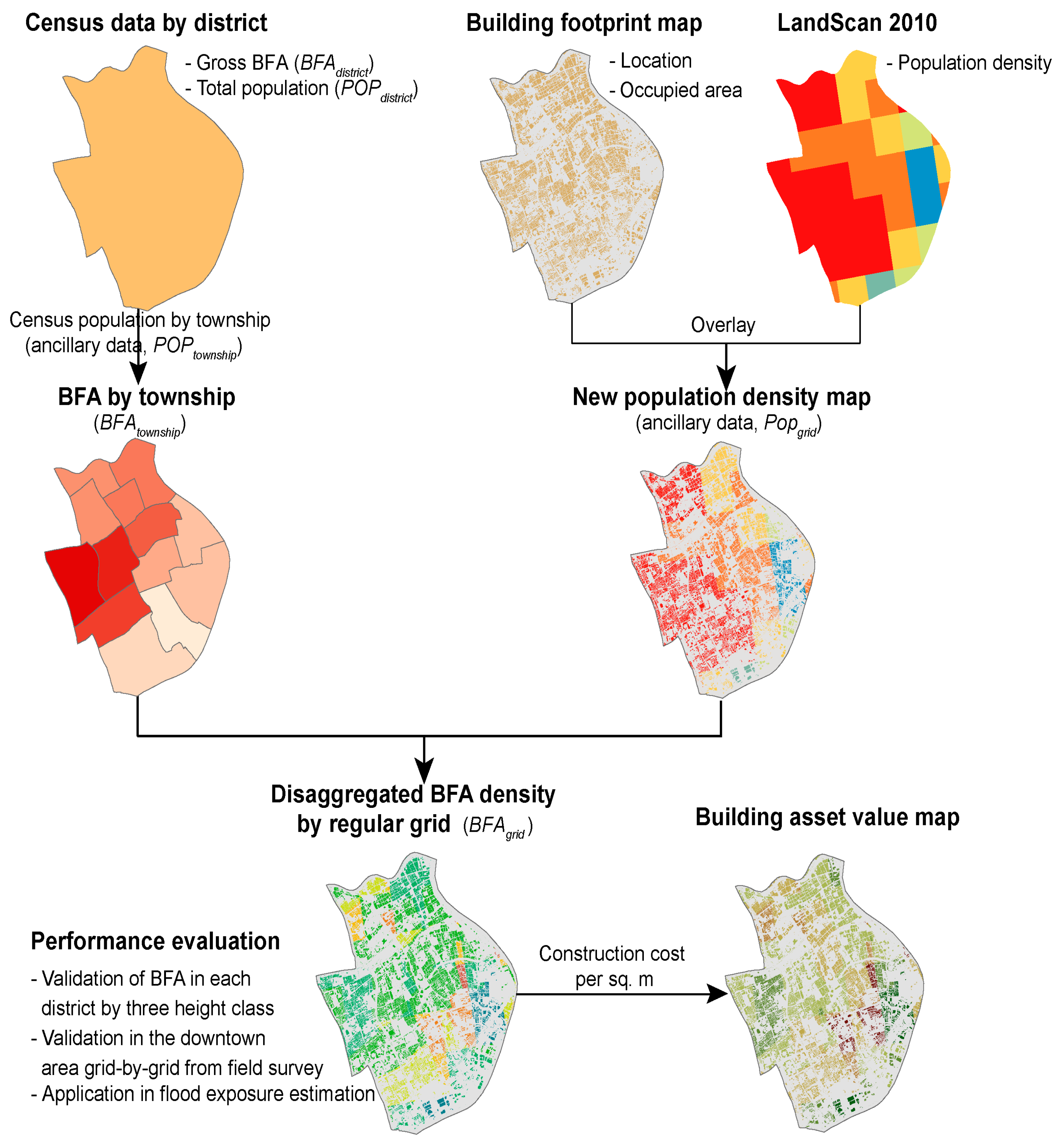

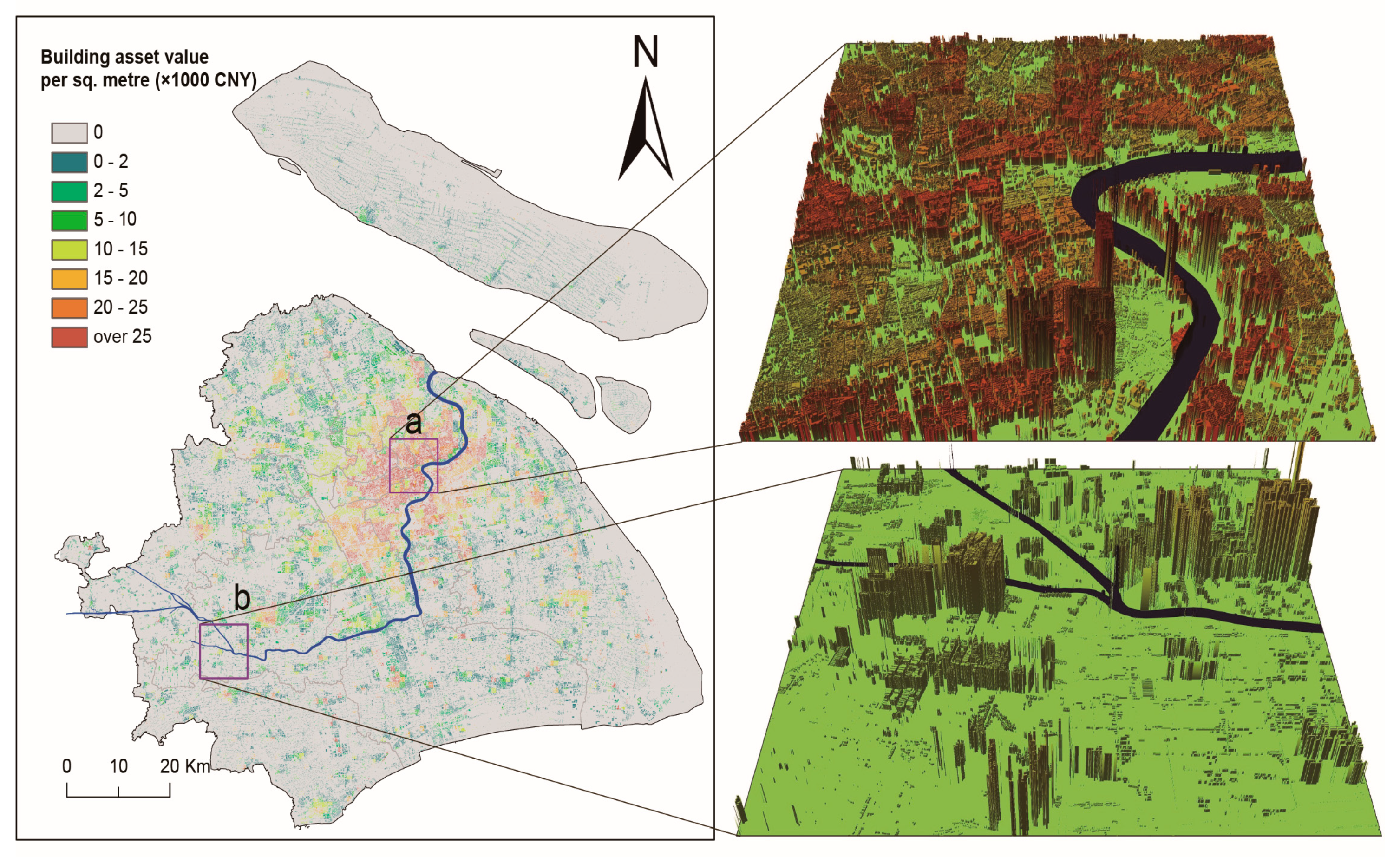
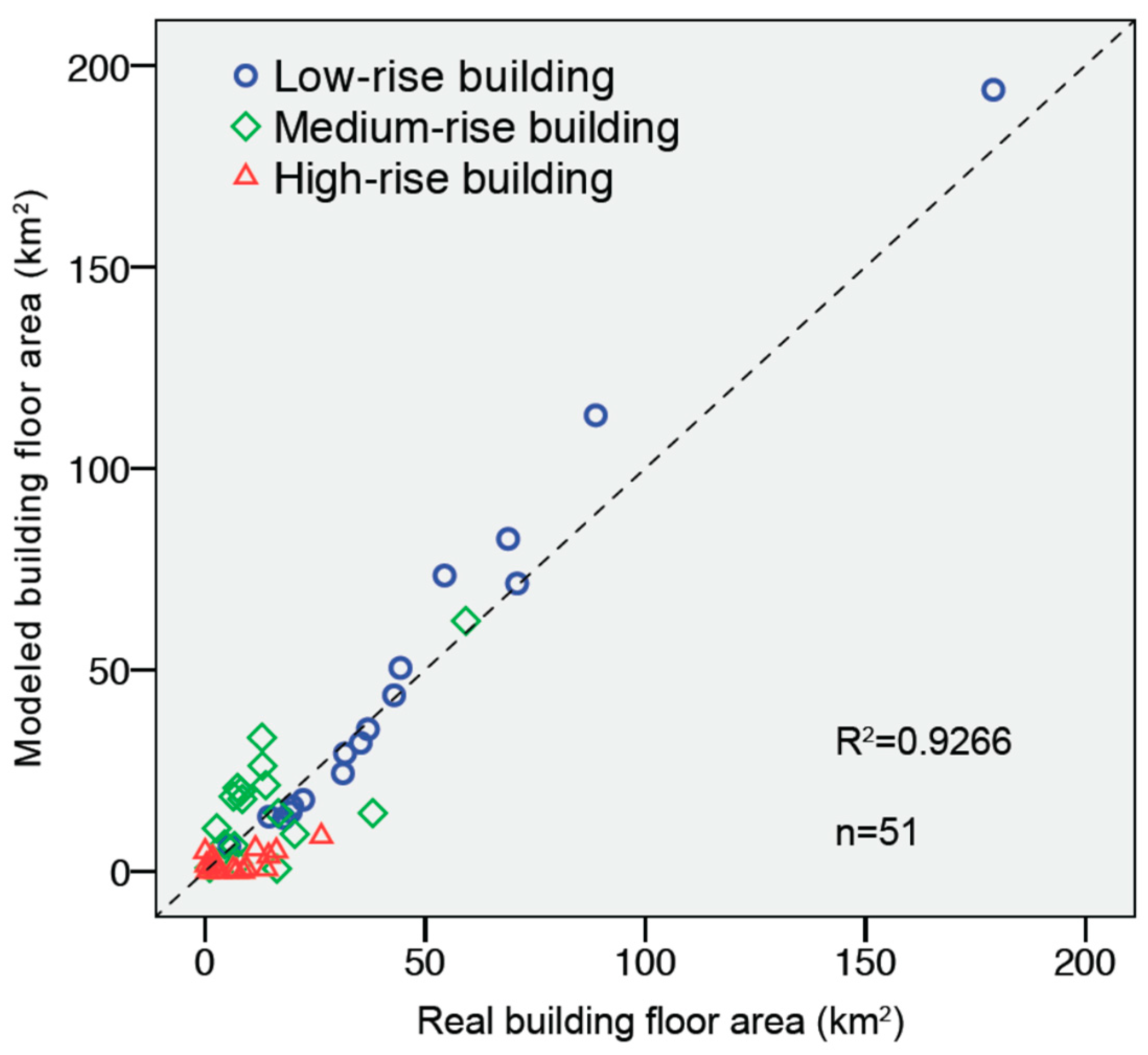
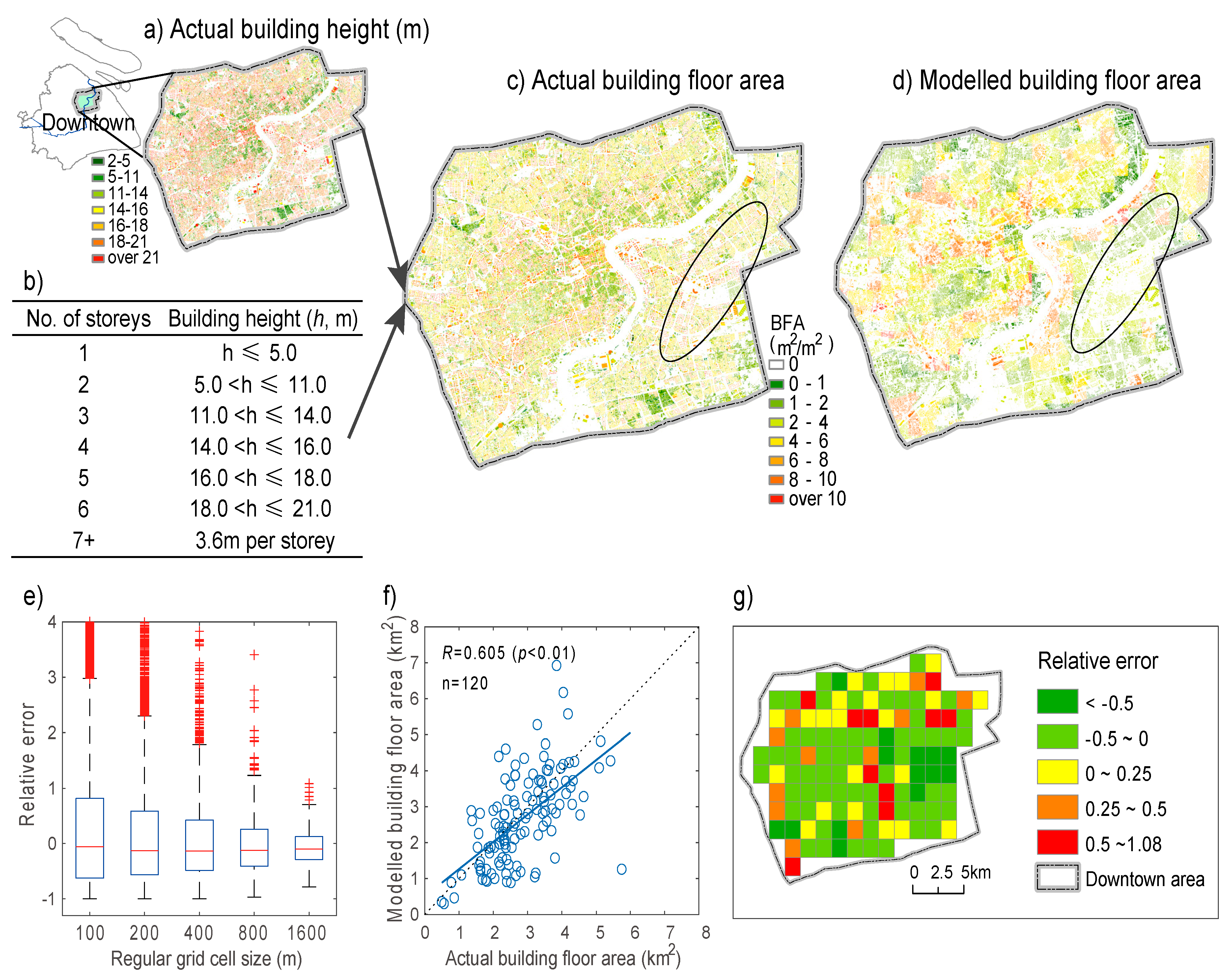


| Data Name | Data Type | Spatial Resolution | Data Source | Data Year |
|---|---|---|---|---|
| Total population (persons) per township | Statistical data | Township level | SMSB [46] | 2010 |
| Total population (persons) per district | Statistical data | District level | SMSB [45] | 2014 |
| Total BFA (km2) with six height classes | Statistical data | District level | SMSB [45] | 2014 |
| Yearly completed construction floor area (km2) and its cost [Chinese Yuan (CNY) per m2] of construction by building use type | Statistical data | Shanghai | SMSB [45] | 2014 |
| Building footprint maps | Vector | Per building | Map World of Shanghai (www.shanghai-map.net) | 2013~2014 |
| Actual building height (m) information in downtown area | Vector | Per building | Field survey and aerial images | 2014~2015 |
| LandScan population density (persons per km2) grid | Raster | 30’’ (~800 m in Shanghai) | Oak Ridge National Laboratory [47,48] | 2010 |
| District | Population (Thousands) | Gross BFA (km2) | Gross BFA by Height Class (%) | Gross BFA by Building Use Type (%) | Average Construction Cost per sq. m (in 2014 Prices) | ||||||
|---|---|---|---|---|---|---|---|---|---|---|---|
| Residential Building | Non-Residential Building | 1~7 Storeys | 8~19 Storeys | ≥20 Storeys | Residential Building | Office Building | Commercial Building | Other | |||
| Pudong | 5451.2 | 142.9 | 121.8 | 67.6 | 22.4 | 10.0 | 54.0 | 5.6 | 6.3 | 34.2 | 4417.3 CNY (USD 719.1) |
| Huangpu | 682.0 | 17.6 | 19.6 | 39.1 | 17.3 | 43.5 | 47.3 | 19.4 | 13.9 | 19.5 | 5133.1 CNY (USD 835.6) |
| Xuhui | 1109.7 | 33.9 | 25.3 | 53.7 | 22.0 | 24.3 | 57.3 | 11.9 | 6.1 | 24.7 | 4687.3 CNY (USD 763.1) |
| Changning | 698.6 | 24.1 | 15.6 | 49.9 | 21.3 | 28.8 | 60.7 | 12.4 | 8.0 | 18.9 | 4758.4 CNY (USD 774.6) |
| Jing’an | 248.6 | 8.2 | 9.4 | 31.3 | 15.1 | 53.5 | 46.5 | 20.4 | 11.5 | 21.6 | 5124.0 CNY (USD 834.1) |
| Putuo | 1296.1 | 36.0 | 22.2 | 53.8 | 22.2 | 23.9 | 61.9 | 7.9 | 7.6 | 22.6 | 4566.5 CNY (USD 743.4) |
| Zhabei | 848.5 | 22.6 | 14.9 | 59.3 | 21.6 | 19.1 | 60.2 | 7.8 | 7.8 | 24.2 | 4557.5 CNY (USD 741.9) |
| Hongkou | 838.2 | 22.3 | 13.2 | 54.9 | 20.8 | 24.4 | 62.9 | 11.5 | 7.4 | 18.2 | 4718.5 CNY (USD 768.1) |
| Yangpu | 1323.7 | 33.8 | 23.3 | 64.8 | 24.1 | 11.1 | 59.1 | 7.2 | 4.9 | 28.8 | 4467.1 CNY (USD 727.2) |
| Minhang | 2539.5 | 75.2 | 54.2 | 68.6 | 29.5 | 2.0 | 58.1 | 2.2 | 5.0 | 34.7 | 4255.0 CNY (USD 692.7) |
| Baoshan | 2024.0 | 54.0 | 37.8 | 75.0 | 22.2 | 2.8 | 58.9 | 2.7 | 5.4 | 33.0 | 4288.3 CNY (USD 698.1) |
| Jiading | 1566.2 | 33.6 | 40.4 | 73.5 | 22.1 | 4.5 | 45.4 | 5.0 | 7.9 | 41.6 | 4394.0 CNY (USD 715.3) |
| Jinshan | 797.1 | 14.7 | 25.4 | 88.2 | 11.0 | 0.8 | 36.6 | 3.4 | 8.7 | 51.3 | 4313.8 CNY (USD 702.3) |
| Songjiang | 1755.9 | 39.5 | 49.8 | 79.5 | 18.7 | 1.9 | 44.2 | 1.9 | 5.9 | 47.9 | 4217.0 CNY (USD 686.5) |
| Qingpu | 1208.3 | 21.2 | 31.1 | 84.8 | 14.1 | 1.1 | 40.6 | 2.2 | 6.8 | 50.5 | 4232.8 CNY (USD 689.1) |
| Fengxian | 1167.6 | 21.6 | 29.2 | 84.5 | 13.1 | 2.3 | 42.5 | 2.9 | 6.9 | 47.7 | 4274.0 CNY (USD 695.8) |
| Chongming | 701.6 | 9.7 | 9.3 | 94.4 | 5.6 | 0.1 | 51.0 | 3.4 | 6.0 | 39.7 | 4302.3 CNY (USD 700.4) |
| Shanghai | 24256.8 | 610.9 | 542.5 | 68.0 | 21.1 | 10.9 | 53.0 | 5.9 | 6.7 | 34.4 | 4433.6 CNY (USD 721.8) |
| Building Use Type | BFA Completed (Million sq. m) | Cost of Construction of Buildings Completed (Billion CNY) | Construction Cost per m2 (in 2014 Prices) |
|---|---|---|---|
| Residential building | 15.4 | 64.4 | 4197.0 CNY (USD 683.2) |
| Office building | 1.7 | 13.4 | 8117.3 CNY (USD 1321.4) |
| Commercial building | 2.1 | 12.4 | 5933.0 CNY (USD 965.8) |
| Others | 4.0 | 15.6 | 3867.2 CNY (USD 629.6) |
| Number of Storeys | Height (h, m) |
|---|---|
| 1 | h ≤ 5.0 |
| 2 | 5.0 < h ≤ 11.0 |
| 3 | 11.0 < h ≤ 14.0 |
| 4 | 14.0 < h ≤ 16.0 |
| 5 | 16.0 < h ≤ 18.0 |
| 6 | 18.0 < h ≤ 21.0 |
| 7+ | 3.6 m per storey |
| Model | Affected BFA (km2) | Ratio |
|---|---|---|
| Best estimate by field survey | 253.43 | - |
| Proposed method by this study | 237.82 | 0.94 |
| No disaggregation (BFA uniformly distributed within district) | 162.02 | 0.64 |
| No disaggregation (BFA uniformly distributed in building occupied area within district) | 174.79 | 0.69 |
| Disaggregation using township population-adjusted BFA (BFA uniformly distributed within township) | 233.01 | 0.92 |
© 2019 by the authors. Licensee MDPI, Basel, Switzerland. This article is an open access article distributed under the terms and conditions of the Creative Commons Attribution (CC BY) license (http://creativecommons.org/licenses/by/4.0/).
Share and Cite
Wu, J.; Ye, M.; Wang, X.; Koks, E. Building Asset Value Mapping in Support of Flood Risk Assessments: A Case Study of Shanghai, China. Sustainability 2019, 11, 971. https://doi.org/10.3390/su11040971
Wu J, Ye M, Wang X, Koks E. Building Asset Value Mapping in Support of Flood Risk Assessments: A Case Study of Shanghai, China. Sustainability. 2019; 11(4):971. https://doi.org/10.3390/su11040971
Chicago/Turabian StyleWu, Jidong, Mengqi Ye, Xu Wang, and Elco Koks. 2019. "Building Asset Value Mapping in Support of Flood Risk Assessments: A Case Study of Shanghai, China" Sustainability 11, no. 4: 971. https://doi.org/10.3390/su11040971
APA StyleWu, J., Ye, M., Wang, X., & Koks, E. (2019). Building Asset Value Mapping in Support of Flood Risk Assessments: A Case Study of Shanghai, China. Sustainability, 11(4), 971. https://doi.org/10.3390/su11040971






